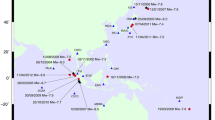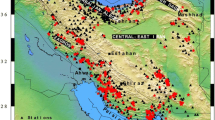Abstract
— From a data set of 150 digital records of T phases from 71 sources obtained on seismometers of the Polynesian Seismic Network, we define a discriminant separating earthquake and explosion sources, which uses the maximum amplitude of recorded ground velocity, measured on its envelope, e Max (in μm/s), and the duration of the phase measured at 1/3 of maximum amplitude, τ1/3 (in seconds). Earthquake sources and man-made explosions are effectively separated in a log-log space by the straight line ¶¶log10 e Max = 4.9 log10τ1/3 - 4.1 .¶¶Other criteria in both the time and frequency domains fail to reliably separate the populations of the various kinds of events. The application of this technique to analog records of large-scale man-made explosions carried out in the 1960s confirms that it provides an adequate discriminant over 3.5 orders of magnitude of ground velocity.
Similar content being viewed by others
Author information
Authors and Affiliations
Additional information
(Received June 30, 1999, revised November 8, 1999, accepted November 15, 1999)
Rights and permissions
About this article
Cite this article
Talandier, J., Okal, E. Identification Criteria for Sources of T Waves Recorded in French Polynesia. Pure appl. geophys. 158, 567–603 (2001). https://doi.org/10.1007/PL00001195
Issue Date:
DOI: https://doi.org/10.1007/PL00001195




